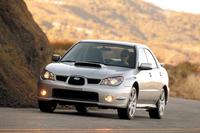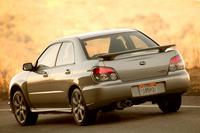2006 Subaru WRX Sedan Review
DRIVING DOWN THE ROAD
WITH CAREY RUSS
2006 Subaru WRX Sedan
Subaru Before: The unofficial official car of the snowy northern corners of the country, and then creator of the Outback SUV-car crossover. Functional, practical, but not particularly exciting. Subaru After: Serious all-wheel drive high-performance excitement. Before and after what? The WRX, of course. Perhaps never has one car changed its makers' image in the public mind more than the WRX. Pre-WRX, a Subaru was what your aunt in Vermont drove. After, it's what your teenage son dreams about.
And for 2006, the WRX gets its first major makeover since its model year 2002 introduction. Outside, the front end has been restyled with the new Subaru look, as debuted in the company's Tribeca SUV. But that's not the most important change. Under the aluminum hood, the 2.0-liter, 227-horsepower boxer four, a legacy of the displacement requirements for the World Rally Championship cars from which the WRX was descended, is gone, replaced by a detuned version of the 2.5-liter STi engine also found in the Forester XT. The suspension, brakes, and steering have been upgraded for further performance improvements. There is even some increased sound insulation, for a quieter driving experience.
The WRX lineup has expanded. At a lower price point and equipment level is the TR sedan (that's ``Tuner Ready''), which shares exterior and interior trim with the Impreza 2.5i sedan. Above the standard sedan and sport wagon are the Limited models of both body styles. Equipped with leather upholstery, heated front seats and mirrors, a glass moonroof, and more, they are meant to appeal to people who might otherwise be more inclined towards a European car. Clearly, Subaru intends for the WRX to keep its status as the benchmark of the sport-compact class. Having spent the last week with an `06 WRX sedan in absolutely box-stock trim with no options - and no options necessary - I'd say they've succeeded. It's a little more comfortable and less raucous, but with absolutely no loss of character. The driver's office is near-perfect, the new engine is stronger where it counts, at the low end and in the midrange, with no loss at the top. The chassis upgrades, while incremental, are significant. The extra refinement comes with no loss of character - the WRX is still the bad boy it always has been at heart, it's just a touch kinder to its passengers.
APPEARANCE: Subaru styling has always been different, and the company is not going mainstream anytime soon. For 2006, all Impreza and WRX models get a front facelift that echoes themes first shown on the B11S concept car a couple years ago, and more recently on the Tribeca SUV. The three-section grille is ``inspired by the company's aircraft heritage'' according to product literature. The headlights are also new. The remainder of the body is unchanged, with the exception of STi-style side sills and new taillights. The functional air scoop and fender blisters remain. A small rear wing is optional.
COMFORT: Visible changes to the standard WRX's interior are minimal. It's functional yet stylish in the sport-compact idiom, which means a good instrument and control layout and silvery plastic trim highlights. All models have at least power windows, mirrors, and locks with remote keyless entry, air conditioning, an engine-immobilizer security system, and an AM/FM/CD stereo. The regular model's bolstered, high-back front sports seats provide a high level of comfort and support, especially in enthusiastic driving. As always, the rear seat offers room for two or three people, and there is plenty of useful trunk space. ``Sports car'' no longer means purely two-seat minimalist transportation. Not visible, but notable and appreciated, is increased soundproofing. There is not a lot - no one will mistake a WRX for a luxury car, and that is as it should be - but it does take the edge off and reduces noise-induced fatigue.
SAFETY: From a structural standpoint, the Subaru Ring Frame Reinforced body structure gives the WRX very good crash safety. All models have four-wheel antilock disc brakes with electronic brake-force distribution. Earlier models were not exactly deficient in stopping power, but the `06 has them beat. At the front, four-piston calipers have replaced the previous twin-piston ones, for greater stopping power on the vented rotors. Larger discs, now vented for improved heat dissipation, are found in the rear, grabbed by twin-piston calipers. These replace a solid disc, single-piston setup. All models now have the dual-stage Subaru Advanced Frontal Airbag system and front side airbags.
RIDE AND HANDLING: The WRX's rigid chassis benefits its ride and handling, and a reduction in unsprung weight by use of aluminum in the front suspension lower arms and a quicker steering ratio improve responsiveness. The suspension setting is firm but nowhere near as harsh as the STi, making the WRX a very reasonable daily drive. Seventeen by 7.5-inch alloy wheels with 215/45 tires replace the previous 16x6.5 wheels and 205/55 tires. They, and the quicker steering, make the WRX sensitive to both driver input and the road, but not nearly as much as the STi. Straight-line stability is still good, and turn-in is sharp and immediate. All-wheel drive with a static 50/50 torque distribution gets the considerable power to the ground, with fore-and-aft transfer automatically changing to send power to the wheels that have the most traction. More power, improved suspension, what can I say? The WRX is more fun than ever.
PERFORMANCE: There is more than a little STi in every WRX now, and it's not particularly surprising. A detuned version of the 2.5-liter STi engine was found in the Forester XT when it debuted a few years ago, and, with some further modification, it now nestles in the WRX's engine compartment, too. Like the old engine, it's a turbocharged and intercooled 16-valve dual overhead cam boxer four, but a semi-closed deck design, forged high-carbon steel connecting rods, and other internal modifications make it stronger than the old 2.0-liter block. Variable valve timing widens the power band. Less boost means less power than the STi, but it's not deficient. While the horsepower spec, 230 at 5600 rpm, is virtually identical to the old engine's 227, torque has increased from 217 lb-ft to 235, at a lower 3600 rpm. While top-end power, never deficient, is unchanged, the low end and midrange get a very welcome and useful boost. Turbo lag is nonexistent as long as the revs are kept up, and minimal when they drop too low. My test car had the standard five-speed manual gearbox, which suits the car's character well. A four-speed automatic is offered only in the Limited model.
CONCLUSIONS: Subaru stays at the top of the sport-compact class with significant improvements to the 2006 WRX.
SPECIFICATIONS: 2006 Subaru WRX Sedan
Base Price $ 24,995
Price As Tested $ 25,620
Engine Type horizontally-opposed dual overhead cam
turbocharged and intercooled 16-valve
four-cylinder with variable valve timing
Engine Size 2.5 liters / 150 cu. in.
Horsepower 230 @ 5600 rpm
Torque (lb-ft) 235 @ 3600 rpm
Transmission 5-speed manual
Wheelbase / Length 99.4 in. / 175.8 in.
Curb Weight 3,192 lbs.
Pounds Per Horsepower 13.9
Fuel Capacity 15.9 gal.
Fuel Requirement 91 octane unleaded premium gasoline
Tires P215/45 WR17 Bridgestone Potenza RE92
Brakes, front/rear vented disc / vented disc
Suspension, front/rear independent MacPherson strut /
independent modified strut
Drivetrain front engine, full-time all-wheel drive
PERFORMANCE
EPA Fuel Economy - miles per gallon
city / highway / observed 20 / 26 / 20
0 to 60 mph 5.8 sec
OPTIONS AND CHARGES
Destination charge $625





